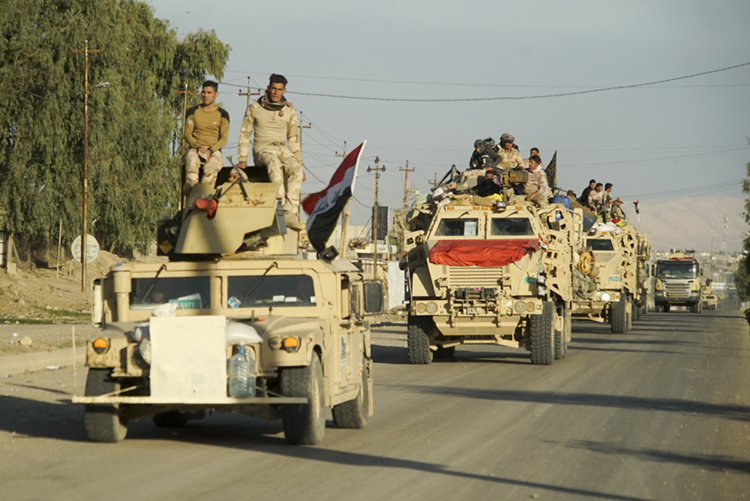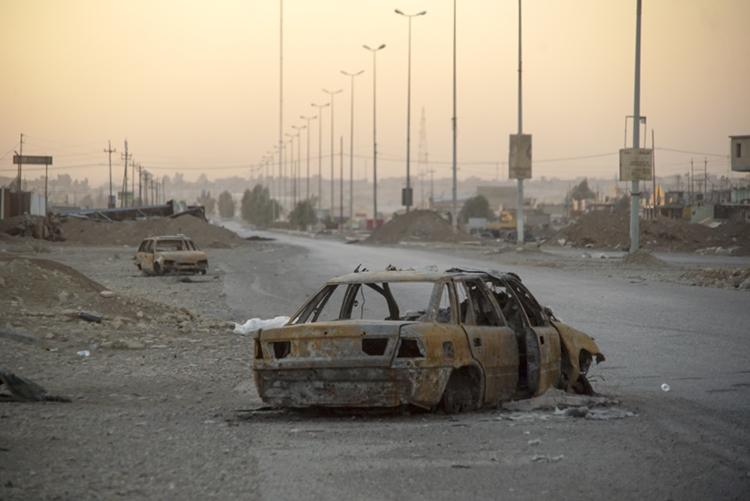An Iraqi federal policeman tries to draw fire from an Islamic State sniper in Mosul, Iraq, in April 2017. If the sniper fires, he may reveal his position. Credit: © Carl Court, Getty Images
On July 10, Iraqi Prime Minister Haider al-Abadi declared victory for government forces in their bloody battle with Islamic State militants for possession of the northern city of Mosul. One of Iraq’s largest cities, Mosul had been under Islamic State control since the terrorist group took it by force in June 2014. The government campaign to retake the city began in October 2016.
Islamic State is the name used by a radical militant Sunni Islamist group based in Iraq and Syria. The group is known for its ruthless violence and severe interpretation of the Shari`ah, the legal and moral code of Islam. In June 2014, Islamic State leader Abu Bakr al-Baghdadi proclaimed the establishment of a caliphate from the steps of the Grand Mosque of al-Nuri in Mosul. A caliphate is a government ruled by a caliph, a leader with political and religious authority recognized by Muslims as a successor of the Prophet Muhammad. No one outside the Islamic State—which is merely a well-organized terrorist group—recognized the so-called caliphate, however, and it is often referred to as the Islamic State in Iraq and Syria (ISIS), the Islamic State in Iraq and the Levant (ISIL), or by the acronym DAESH, based on the group’s full Arabic name (al-Dawla al-Islamiya fi al-Iraq wa al-Sham). For the past several years, the group has been fighting for control of parts of Iraq and Syria and has killed thousands of people in high-profile terror attacks in Europe and the Middle East.
Northeastern Iraq is largely Kurdish, and peshmerga (Kurdish for those who confront death) fighters led a first attempt to liberate Mosul in early 2015. Coinciding Islamic State assaults on the city of Ramadi—much closer to Baghdad, the Iraqi capital—prevented the Iraqi Army from supporting the Kurds in Mosul, however. The peshmerga pried several suburban villages from Islamic State control, but they lacked the numbers and firepower to free the city itself.

Iraqi soldiers and heavy vehicles head for the fighting in Mosul, Iraq, in November 2016. Credit: Mstyslav Chernov (licensed under CC BY-SA 4.0)
Hard fighting around Mosul resumed in the spring of 2016 as the government worked to cut off Islamic State supply routes out of the city. Government-led forces slowly tightened the net around Mosul through the summer and into autumn. Civilians in the city, already suffering under Islamic State rule (there were numerous random killings and mass executions), fled Mosul in increasing numbers—as did many Islamic State fighters. By early October, the estimated number of Islamic State militants in Mosul had shrunk to between 3,000 and 5,000, down from roughly 20,000 earlier in 2016.
On October 16, some 100,000 troops—mostly from the Iraqi army but many from peshmerga, Shi`ite, and other local militias—gathered on the outskirts of Mosul. With close air and artillery support from a United States-led coalition, Iraqi forces entered eastern Mosul the next day. They advanced against fierce pockets of Islamic State resistance, rigged explosives, and other improvised defenses. Civilians were often caught in the crossfire, particularly as Islamic State fighters used them as human shields and deterrents against coalition air and artillery strikes. Still, eastern Mosul steadily fell to government troops through November and December as assaults from the north and west put further pressure on the city’s Islamic State defenders. On Jan. 24, 2017, Prime Minister al-Abadi announced the “full liberation” of eastern Mosul.

Burned out cars and rubble flank a deserted road in Mosul, Iraq, in November 2016. Fighting in Mosul left much of the city in ruins. Credit: Mstyslav Chernov (licensed under CC BY-SA 4.0)
The offensive to liberate Mosul’s western half (the city is divided by the Tigris River) began on February 19. Government forces advanced from neighborhood to neighborhood, fighting from building to building both on the streets and below them in tunnels. Islamic State forces dwindled but maintained fierce and often suicidal resistance. By April, their remaining numbers had gathered in western Mosul’s old city or retreated in small groups to the city’s outskirts. By June, resistance had shrunk to a few blocks surrounding the old city’s Grand Mosque of al-Nuri. As a last act of defiance before dying in battle, Islamic State fighters destroyed the 844-year-old Grand Mosque. Shocked, saddened, and exhausted government troops at last annihilated Islamic State resistance in early July, ending the battle.
The fight for Mosul destroyed large parts of the ancient and historic city. More than 2,000 Islamic State militants died in the battle. Reports that their leader, al-Baghdadi, was among the dead remain as-yet unproven. Roughly 1,000 soldiers of the Iraqi government coalition were killed. Civilian deaths are estimated at more than 8,000, and more than 1 million people had to flee their homes. The shell-shocked citizens that remain in Mosul are now in need of food and water, medicine, sanitation, and shelter. The families of slain or escaped Islamic State fighters face a similar crisis as they are gathered in temporary camps outside the city.
For the Islamic State, the loss of Mosul—the birthplace of its “caliphate” and its capital in Iraq—is a costly defeat. However, the war against the terrorist group is far from over. Islamic State militants who fled Mosul now hold nearby towns, and many thousands of other Islamic State fighters remain in Syria and other parts of Iraq.
Untitled Document Can't view the linked articles? Subscribe to World Book Online

World Book Online delivers a progressive sequence of core databases supported by supplemental
tools, such as language translation, graphic organizers, and unique Webquests. Moving from
Early World of Learning to World Book Advanced, World Book Online aligns end-users with their
appropriate learning levels. Each stand-alone site provides additional features to support the
needs of users’ specific capabilities.
The World Book Difference
World Book combines cutting-edge technology with traditional editorial excellence to produce
authoritative, trustworthy, and unbiased content. The digital content is updated in real time and
carefully curated for each learning level. Accessible 24/7, the content is available on a variety of devices.
World Book Online combines 21st-century instructional techniques with timely information.
By breaking down complex topics and using easily understandable text, World Book Online helps to
build fluency and increase comprehension. Featuring single sign-on capability, these sites are paired
with highly visual content to engage even the most reluctant reader. Our collection of resources kindles
a lifelong learning experience for every user. This adherence to clarity, currency, and accuracy makes
World Book’s digital offerings an information hub for the classroom, library, and beyond.
|